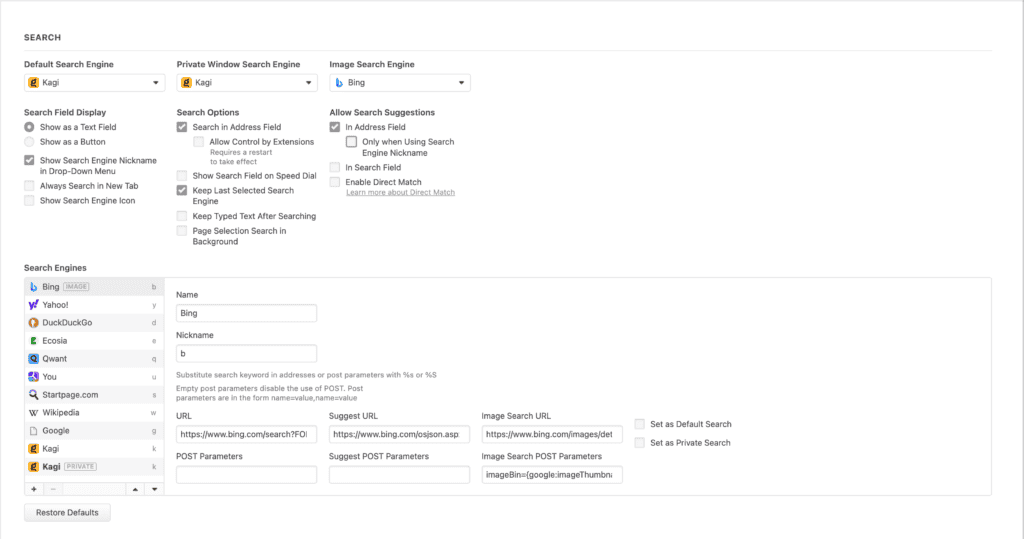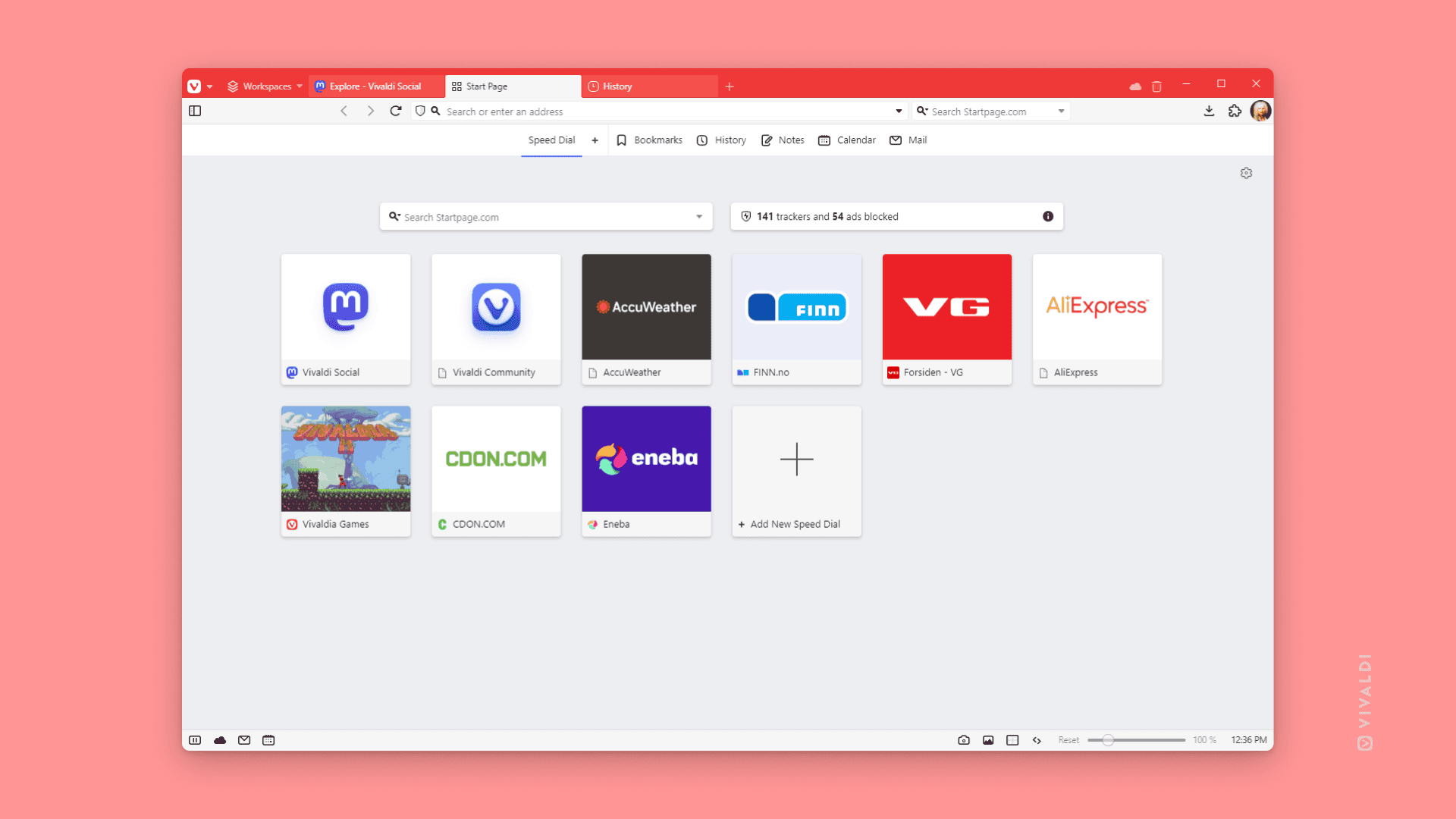I mentioned it in several posts on Mastodon, and also in the week notes for week 18 — I switched to Vivaldi as my primary browser.
I have been using and advocating Safari for years. But recently the most important extension for me — 1password — got worse and worse on Safari. As it started to lock mouse input and broke autocomplete, I needed something new, as the browser is the most used tool during a business day besides the code editor.
First off, I moved to Firefox because I have been using it for years before switching to Safari because of the better system’s integration. A week later, Jeff dropped his article about dropping Chrome and switching to Vivaldi. I heard many good things about Vivaldi and even gave it a try a year ago or so. So I used the time on a train trip to configure Vivaldi to my needs.
So, let’s jump into my setup. Allow me to explain what I disabled and what I enabled. What I like and what not.
What I dislike
Let’s start with the parts of Vivaldi, that I dislike and don’t use at all. I want to mention this first to have sorted this out. Please stick with me to read about the fantastic parts!
Workspaces — I don’t get them. They don’t behave like I want them to behave. I thought they were something like saved sessions and contexts with no other strings attached. But to use them successfully, you have to activate the “restore last session” setting. Something I don’t want at all. Luckily, Vivaldi also has saved sessions, and I am happy. I just had to find them.
Speed dial — A speed dial is not a bad idea at all. But I always configure them and then don’t use them. I replaced it with a simpler and cuter solution: Bonjourr.
Tab groups — Vivaldi offers these tabs on steroids that can be grouped in tab groups. There is for sure a power user that can use them. They confused me totally.
Status bar and panel bar — The default setup of Vivaldi has a very crowded status bar without a single feature of use for me. I disabled it completely. The panel bar has been moved from the left to right and set to hide automatically. I also removed all panels except downloads, saved sessions and the history. Again, panels can be very helpful for some users. For me, they are confusing.
Mail, calendar and feeds — I was reminded of the times of Netscape Communicator. I only tried the feed reader as a potential replacement for Feedbin. It is not even close concerning UI/UX.
Mouse gestures and Rocker gestures — Vivaldi offers a ton of mouse gestures. I always use an Apple Trackpad and love to run my fingers across it. Sadly, this resulted in triggering some of the more destructive gestures, like closing a tab. I disabled them immediately I got aware of them.
That’s it. A short list of things that I don’t like and which can be easily disabled. Now we can jump into the things I use, and I have configured.
Ad blocking and Privacy

The default configuration has some Google services you want to disable if you care about privacy and a Google-free world. Get rid of them. The only services you should leave activated is the “Web Store”. A browser without extensions is no fun at all. In my case, I also leave the “Google Meet” extension on, as I have to use this service regularly.
Ad blocking is a different story. The integrated ad blocker is good and if its result satisfies you, stick with it. It saves memory and is also a bit more performant than other options. For me, it is not good enough, I try to reach 100% on the d3ward test suite. To achieve this, I had to install uBlock Origin from the Web Store. For a less aggressive setup, the built-in solution is more than enough. On iOS, the built-in solution reaches 99%. On desktop, it is somewhere between 74-78%.
Translation

Vivaldi has a built-in translation system powered by Lingvanex. It works pretty well, and I would say it is on an equal level to Google Translator. For me, as a German, Google Translator is not the gold standard when it comes to translating from any language to German or vice versa. As I own a DeepL Pro account, I use, of course, the DeepL Translator extension. But again, if you are fine with Lingvanex, go for it. Concerning privacy, it is a way better solution than Google Translator.
Search

When it comes to search, I would advise to disable Direct Match if you get confused by it, like it happened to me.
Direct match is one of the ways how Vivaldi makes money, so I feel a bit bad about disabling it. But for me, the feature doesn’t work. I am not interested in a quick way to open brand pages or so. See the explanation linked above before disabling it.
The rest of the search features are straightforward. The only issue I had was, that the Kagi extension for Chrome doesn’t work well in Vivaldi. I had to set up Kagi search manually. Easy, but you have to do it.
Pick the search engine you prefer. Don’t use Google. 😉
Address bar

I love how you can configure the address bar and especially the ordering of the autocomplete results in it. You can completely tweak what you want to see and in which order. This is something I haven’t seen in any other browser yet. I only changed the ordering of the items a bit, but I am sure I will tweak this setting more and more in the future.
Keyboard shortcuts
The defaults were confusing for me. So I basically removed all the defaults I don’t need and switched the rest to match the browsers I have been using before.
Please take the advice to review all the shortcuts and see, if you require all of them or want to change some. The good part is, that you can change these shortcuts in an easy-to-use dialog in the settings. Very handy and way better than in any other browser.
One weak spot of Vivaldi is the way it handles keyboard shortcuts for extensions. These might not work as expected when coming from other browsers. See this article from the forum covering workarounds.
Memory management

I switched to Vivaldi when version 6.7 was out. Vivaldi 6.7 includes a new memory manager/saver that is simply outstanding. It keeps the memory usage low and beats even Safari on macOS if you have numerous tabs open. I would assume it would give an even better experience over Firefox for the power user who has 7500 tabs open.
Extensions, I use
I already mentioned some of the extensions I use. Here is a complete list of the few extensions I use.
- 1password — The only password manager that really works for me and that I trust.
- LanguageTool — You need a spell checker? Look nowhere else but install LanguageTool.
- Bonjourr — A wonderful new tab page.
- ClearURLs – I am sick of all the tracking cruft hidden in URLs.
- DeepL Translate – There is no other translation service that handles German so well.
- No Youtube Shorts – YouTube is the only service from Google I want to use and for which I am paying. But Shorts are just useless noise I want to avoid and don’t see at all.
- uBlock Origin – The ad blocker.
- Choosy – My default browser and browser switcher.
My Vivaldi…

… is more like a Google Chrome or Safari without all the extra features Vivaldi normally brings along but with way better privacy and performance than a normal Google Chrome.
The only part that is a bit sad about my love for Vivaldi — I am part of the chromium only world. I always used Safari/WebKit and Firefox to add some diversity to the web rendering engine ecosystem.
Wishes
I would love to pay for Vivaldi.
What’s Vivaldi’s business model?
They are a small company. They have to pay people. I don’t use direct match. I am not using their speed dial. So the only way I support them is by having search engines configured, I use from time to time. This feels a wrong in many ways. Maybe I should see, if I can switch from Kagi to something else again.
